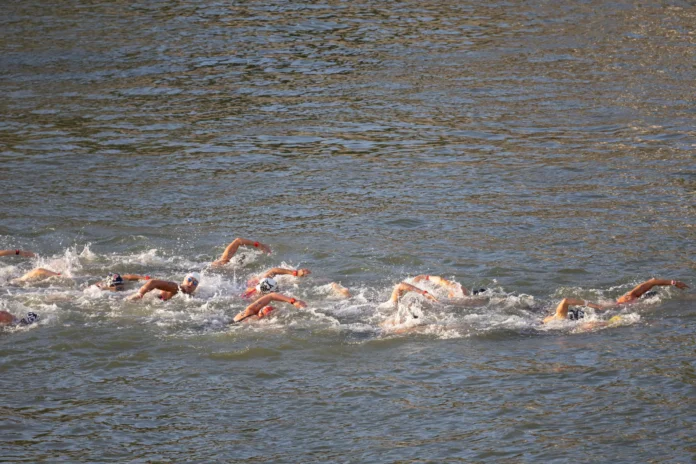
In a historic move marking a significant transformation of the City of Lights, Paris is preparing to reopen sections of the Seine River to swimmers in the summer of 2025.
This announcement comes nearly a century after urban swimming in the Seine was banned due to health and safety concerns linked to increased river traffic.
Reviving a Parisian Tradition
For centuries, the Seine was an integral part of Parisian life, with locals frequently swimming in its waters. By the 17th century, Parisians were known to swim in the Seine, often in the nude.
However, as the city evolved and the river became more congested with boats and pollution, authorities prohibited the practice in 1923.
Since then, swimming in the Seine has been largely confined to private or controlled environments, such as the Bassin de la Villette’s four open-air pools, which have served as a substitute for the river.
The upcoming 2025 initiative will see three designated swimming sites open to the public: Bras Marie, located between the Sully and Marie bridges near the Marais on the right bank; Bras de Grenelle, near the Eiffel Tower on the left bank between the Grenelle port and the Île aux Cygnes; and Bercy, around the Passerelle Simone de Beauvoir between the Tolbiac and Bercy bridges.
The Olympic Influence
The decision to reintroduce swimming in the Seine is partly driven by the success of the Paris 2024 Olympics, which showcased the river’s potential for major international events.
Despite some setbacks, including heavy rainfall that led to the cancellation of training sessions and postponement of the men’s triathlon due to water quality issues, the Olympic events were a significant step toward restoring the Seine’s reputation.
Paris Mayor Anne Hidalgo symbolically dived into the Seine on July 17, 2024, to demonstrate the improved water quality and signal the city’s readiness for future open-water events.
This gesture highlighted the city’s commitment to making the Seine swimmable and paved the way for the 2025 project.
Efforts to Clean the Seine
Efforts to improve the Seine’s water quality have been ongoing since the 1980s. Today, the river supports 34 species of fish, a marked improvement from just two species 40 years ago.
The Paris City Hall’s initiative is part of a broader strategy to tackle urban water pollution and enhance the city’s resilience to climate change.
The Bassin d’Austerlitz, an enormous underground water storage facility next to the Austerlitz train station, plays a crucial role in this effort.
With a capacity equivalent to 20 Olympic swimming pools, the facility collects excess rainwater and prevents wastewater from contaminating the Seine.
Public Reaction and Anticipation
The reopening of the Seine to swimmers has generated a mixed but largely positive response from both Parisians and visitors. Henry Gibbs, a set designer from Bristol who moved to Paris six months ago, expressed enthusiasm about the initiative.
“I really like the idea of swimming in the Seine, having heard about the recent work to clean it,” Gibbs said.
His friend James Griffiths, a photographer, echoed this sentiment, noting the inconvenience of traveling outside the city for swimming.
“The most annoying thing in summer is having to travel outside the city, down to the river at Fontainebleau, to go swimming,” Griffiths remarked.
In contrast, some locals remain skeptical about the plan. Eliza, an assistant lecturer in Paris, admitted her reservations, stating, “At the moment, I don’t think I would dive in the Seine. I still feel it might be a little unclean.”
Similarly, Layla, a Californian working in Paris, recalled seeing swimmers in the Canal Saint Martin and described it as “gross.” However, she indicated she might consider swimming if others were seen enjoying the Seine.
Infrastructure and Safety Measures
The Seine swimming areas will differ from the existing canal pools. While the canal pools at Bassin de la Villette are enclosed with flat floaters and water flows naturally into them, the Seine swimming sites will offer a more natural experience.
There will be no enclosed pools, and lifeguards will be stationed to ensure safety. Floaters will mark the boundaries at the Bercy location, while Bras Marie and Bras Grenelle will be closed to river traffic during swimming hours.
Antoine Guillou, Paris’s deputy mayor in charge of sanitation, emphasized the project’s rigorous oversight. “The City of Paris will submit a dossier in the coming months to both the Regional Prefecture and the Regional Agency for Health.
The final word belongs to the Regional Prefecture,” Guillou stated. The project will involve regular laboratory tests for bacterial contamination and real-time monitoring tools to ensure water safety.
A Sustainable Solution
The reopening of the Seine aligns with Paris’s broader strategy to address climate change and provide residents with sustainable recreational options. With increasing heatwaves, the initiative offers a much-needed respite for a city with over two million inhabitants.
It reflects a growing trend in European cities to make urban waterways accessible for swimming, enhancing both the quality of life and the city’s environmental resilience.
As Paris prepares for this new chapter in its relationship with the Seine, the 2025 initiative represents a bold step towards reconnecting with the river and embracing its historical and cultural significance.
For many, it will be a return to a cherished tradition and a testament to the city’s commitment to improving urban living conditions amidst the challenges of modernity.